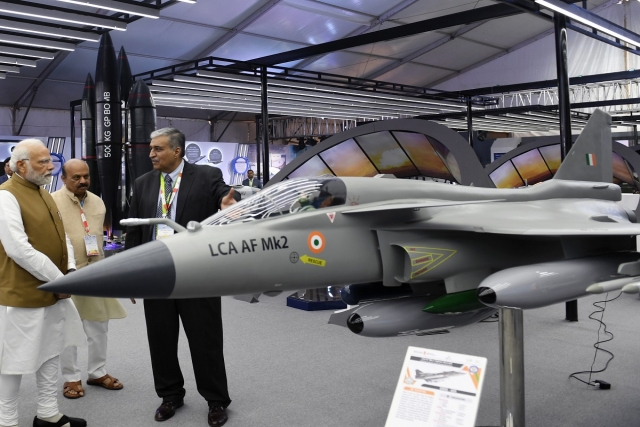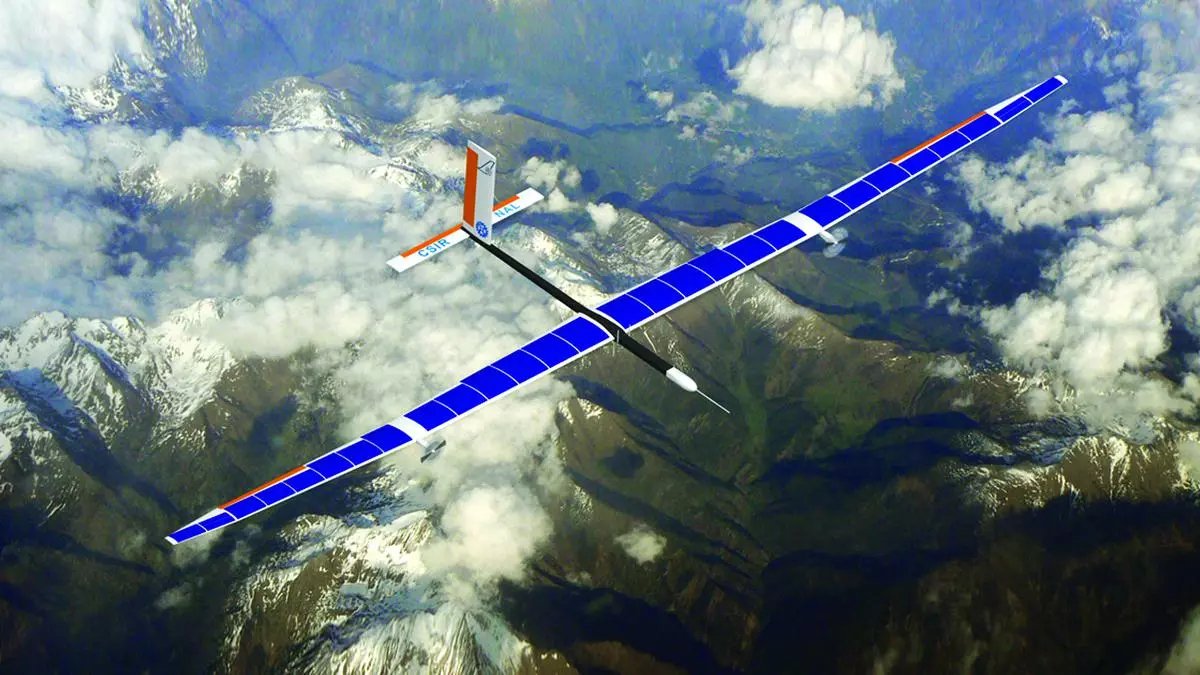SOURCE: RAUNAK KUNDE / NEWS BEAT / IDRW.ORG

Undeterred by the recent crash of the TAPAS UAV during an experimental flight trial in nearby farmland from ATR Challakere, Karnataka, plans for user trials of the TAPAS UAV remain steadfast. The trials, originally slated to commence later this year, will proceed as scheduled, according to information obtained by idrw.org.
The recent crash marks the second instance of TAPAS experiencing an accident in the past four years, but preliminary reports suggest that the crash might not be linked to any technical defects, reinforcing the dedication to advancing the program.
Continue readingSOURCE: RAUNAK KUNDE / NEWS BEAT / IDRW.ORG

In a strategic move aimed at bolstering its aerial prowess and modernizing its fleet, the Indian Air Force (IAF) has taken a decisive step by placing orders for an additional 100 Tejas Mk1A fighter jets. The acquisition of 100 more Tejas Mk1A fighter jets will translate to an augmentation of five squadrons, making significant strides in replacing the retiring Mig-21 and Mig-29 squadrons.
The phased retirement of the Mig-21 and Mig-29 squadrons is a necessary step in the IAF’s evolution. The Mig-29, a stalwart in the IAF’s fleet for nearly four decades, is nearing the end of its airworthy lifespan. With around five to six years of operational viability left, the IAF’s plans to procure 21 unused Mig-29 aircraft from Russia faced a hurdle due to economic and trade sanctions imposed by Western and European countries.
Continue readingSOURCE: IDRW.ORG TEAM

Indian state-owned Hindustan Aeronautics Limited (HAL) is poised to meet its commitments by delivering 11 LCA-Tejas fighter jets by the end of the current financial year, scheduled for March 2024. The development aligns with the nation’s efforts to bolster its indigenous defense capabilities and strengthen its air force fleet.
Among the aircraft to be delivered are eight LCA trainer aircraft, alongside three Tejas Mk1A fighter jets. This delivery schedule reaffirms HAL’s dedication to meeting project deadlines, a crucial aspect in modern defense procurement and manufacturing.
Continue readingSOURCE: IDRW.ORG TEAM

India’s indigenous defense capabilities are set to take another leap forward with the upcoming production of the Light Combat Aircraft Mk2 (LCA-Mk2), a state-of-the-art fighter aircraft that promises to elevate the nation’s aerial prowess. The collaborative efforts of the Indian Air Force (IAF) and Hindustan Aeronautics Limited (HAL) are driving this ambitious project, with a rescheduled timeline aimed at ensuring higher indigenous content in the aircraft.
The green light for the LCA-Mk2 project was given by the Cabinet Committee on Security (CCS) in September 2022, with an allocated budget of ?9,000 crore. This advanced fighter jet is expected to hit the skies for its maiden flight in approximately three years, heralding a new era in India’s defense capabilities.
Continue readingSOURCE: RAUNAK KUNDE / NEWS BEAT / IDRW.ORG

The Indian Air Force (IAF) is taking decisive steps to halt the gradual decline in its fighter jet squadron numbers. In a strategic move to bolster its aerial prowess, the IAF is in the process of introducing an additional 90-100 Tejas Mk1A fighter jets, building on the initial order of 73 placed in 2021.
Earlier this year, a significant milestone was achieved as Defence Secretary Giridhar Aramane inaugurated the third production line of the Light Combat Aircraft (LCA) at the Hindustan Aeronautics Ltd. (HAL) facility in Nashik, Maharashtra. This new production line is poised to play a pivotal role in the induction of the Tejas Mk1A fighter jets into the IAF’s fleet.
Continue readingSOURCE: RAUNAK KUNDE / NEWS BEAT / IDRW.ORG
Argentina, a country without an active fighter jet fleet, is poised to make a crucial decision that could reshape its defence capabilities and strategic partnerships. As the nation deliberates over the purchase of 15 fighter jets by the end of this year, fierce competition is underway between two contenders: India’s LCA-Tejas and China’s JF-17 fighter jets. This choice carries significant implications for Argentina’s defence posture and global alliances.
The backdrop of this decision is complex, with multiple geopolitical factors at play. The United States Congress is considering transferring ex-Danish F-16A/B fighter jets to Ukraine, which is embroiled in a conflict with Russia. The possibility of these jets being offered to Argentina adds another layer of intrigue to the situation.
Continue readingSOURCE: RAUNAK KUNDE / NEWS BEAT / IDRW.ORG
The Defense Research and Development Organization (DRDO) recently issued a Request for Expression of Interest (REOI), DRDO has initiated the process of identifying and shortlisting potential Defense Collaborative Production Partners (DCPPs) for the development and production of Missile/Bomb weapon system projects under the Missile System and Subsystem (MSS) cluster.
The objective of this initiative is to forge strong partnerships with capable Indian companies to collaboratively bring to fruition the ambitious missile and bomb weapon system projects envisioned by DRDO.
Continue readingSOURCE: IDRW.ORG TEAM
As the Indian Air Force (IAF) forges ahead with its ambitious modernization plans, a significant development is on the horizon that could shape the nation’s aerial defense capabilities for decades to come. The IAF’s decision to retain and revamp its Sukhoi Su-30MKI fighter jets until 2050 is set to redefine India’s defense strategy and maintain its air superiority well into the future.
The Sukhoi Su-30MKI, a multirole fighter jet, has been a cornerstone of India’s air power since its introduction. With 222 of these advanced aircraft already inducted into the IAF and production by Hindustan Aeronautics Limited (HAL) concluding in 2021, the stage is now set for a comprehensive overhaul that would ensure the aircraft’s combat readiness for the next three decades.
Continue readingSOURCE: IDRW.ORG TEAM

The Light Combat Aircraft Tejas, affectionately known as LCA-Tejas, has taken another stride forward in its journey towards advanced aerial capabilities. Recent sightings of the aircraft reveal it flying with an Advanced Self-Protection Jammer (ASPJ) Pod, signifying a significant enhancement in its defensive capabilities. This state-of-the-art jamming system is built on the foundation of Active Phased Array (APA) technology, bolstered by ultra-wideband Digital Radio Frequency Memory (DRFM).
The incorporation of the ASPJ Pod in the LCA-Tejas marks a pivotal development, as this cutting-edge system serves as a robust defense mechanism against a range of threats. Ground-based acquisition radars, fire control radars, anti-aircraft artillery, and airborne multimode radars pose formidable challenges during combat missions. The ASPJ Pod, with its sophisticated technology, ensures that the aircraft can counteract and thwart these threats effectively.
Continue readingSOURCE: RAUNAK KUNDE / NEWS BEAT / IDRW.ORG

Indian Ministry of Defense’s (MoD) Collegiate Committee has granted Approval in principle (AIP) for the indigenous development of the Air-Launched Range Land Attack Cruise Missile (LRLACM) for the Indian Air Force to be used from Fighter jets.
The LRLACM is a homegrown, subsonic missile that is being developed to cater to the requirements of the Indian Army, Indian Air Force, and Indian Navy. Spearheading this ambitious project is the Aeronautical Development Establishment (ADE), a Bengaluru-based DRDO lab known for its contributions to advanced aerospace technologies.
Continue readingSOURCE: RAUNAK KUNDE / NEWS BEAT / IDRW.ORG

The Indian Ministry of Defence (MoD) has marked a significant step towards bolstering its military capabilities with the Approval In-Principle (AIP) granted for the indigenous development of high-altitude platforms (HAPs). These cutting-edge platforms, designed for border surveillance, have the potential to revolutionize military reconnaissance and surveillance efforts, enhancing national security.
HAPs often likened to drones but with a distinct advantage, are engineered to operate at altitudes ranging from 18 to 20 kilometers above the Earth’s surface. This altitude advantage sets them apart from conventional drones, enabling them to survey vast areas and provide critical data for strategic decision-making. While satellites orbit at much greater altitudes using gravitational forces, HAPs are deployed at a lower altitude, granting them greater manoeuvrability and responsiveness.
Continue readingSOURCE: RAUNAK KUNDE / NEWS BEAT / IDRW.ORG
India’s naval prowess continues to evolve as it inches closer to testing the second generation of its Arihant-class submarines. The S4, an eagerly anticipated addition to this class, is set to showcase enhanced capabilities with a 1000-tonne increase in displacement compared to its predecessor.
The S4, the third submarine in this class, achieved a significant milestone when it was quietly launched at Visakhapatnam in late November of the previous year. Satellite imagery has confirmed that the submarine is now out of the dry dock and positioned in the wet dock, marking a pivotal step toward its operational readiness.
Continue readingSOURCE: IDRW.ORG TEAM

India’s pursuit of self-reliance in defense manufacturing has taken a significant leap forward with the Indian Air Force (IAF) considering the procurement of an additional 100 Tejas Mk1A fighter jets, supplementing the existing order of 83 aircraft. This decision not only bolsters the nation’s defense capabilities but also paves the way for a substantial increase in the indigenous content of these advanced aircraft.
Hindustan Aeronautics Limited (HAL), the state-owned aerospace and defense company, is set to play a pivotal role in boosting the indigenous content of the Tejas Mk1A fighter jets. Presently, the indigenous content stands at an impressive 65 percent. However, with the heightened emphasis on indigenous manufacturing, HAL is poised to elevate this percentage to well over 75 percent in the forthcoming years.
Continue readingSOURCE: IDRW.ORG TEAM

In a significant step toward enhancing maritime cooperation, Javier Paulinich, the Ambassador of Peru, paid a visit to the Indian state-owned shipyard, Mazagon Dock Shipbuilders Limited (MDL). The visit aimed to explore potential collaborations and leverage MDL’s export capabilities to bolster Peru’s naval ambitions.
During the visit, a comprehensive presentation highlighting MDL’s prowess in shipbuilding and export capabilities was showcased to Ambassador Paulinich. The presentation provided insights into MDL’s expertise in ship design, construction, and state-of-the-art facilities. This was followed by a productive discussion between the ambassador and MDL’s management team, where avenues for collaboration and partnership were explored.
Continue readingSOURCE: RAUNAK KUNDE / NEWS BEAT / IDRW.ORG

Francisco Gomes Neto, President & CEO of Embraer, recently highlighted the company’s eagerness to showcase the exceptional capabilities of the C-390 Millennium aircraft in the challenging conditions of India’s high-altitude regions. In a recent media interview, Neto expressed Embraer’s readiness to demonstrate the ruggedness and efficiency of the C-390 Millennium on short or unpaved runways at significant altitudes, at the request of the Indian Air Force (IAF).
The C-390 Millennium, a state-of-the-art transport aircraft, has achieved a significant milestone by attaining Full Operational Capability (FOC) with the Brazilian Air Force in April 2023. Neto emphasized the aircraft’s remarkable versatility, which spans a wide range of operations including air-to-air refuelling, medical evacuation, troop and cargo transport, firefighting, and more.
Continue reading